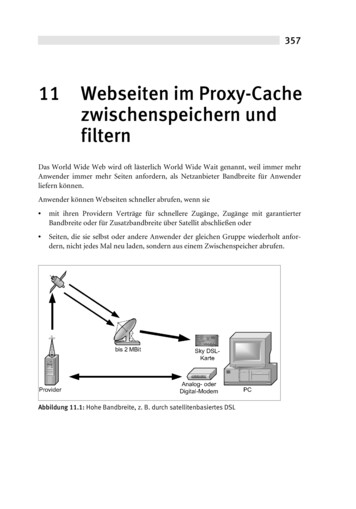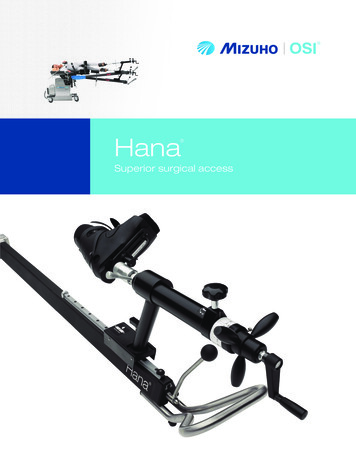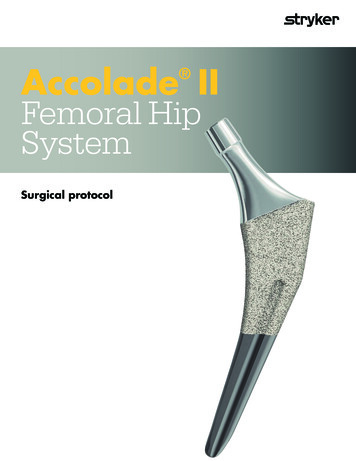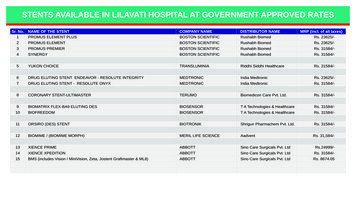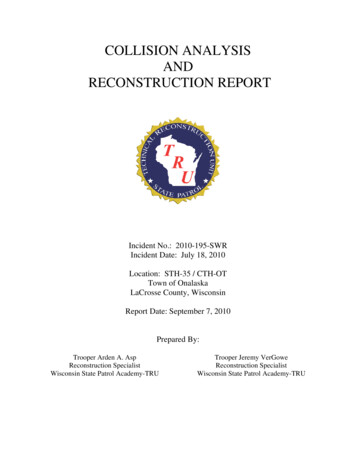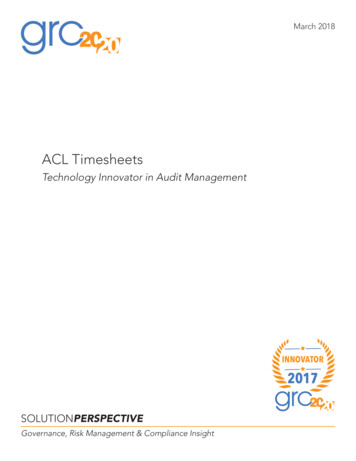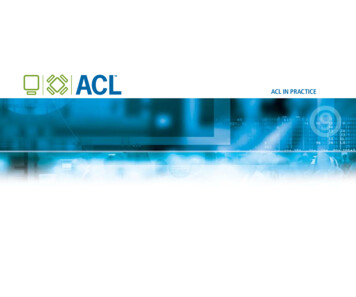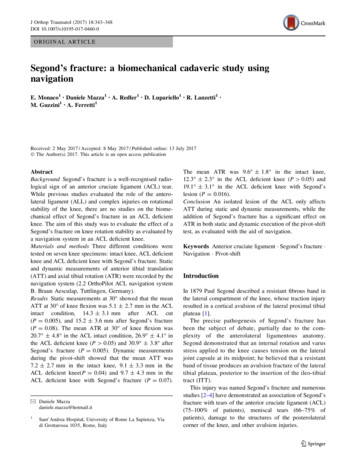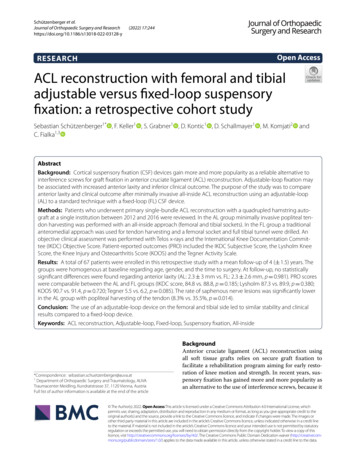
Transcription
Schützenberger et al.Journal of Orthopaedic Surgery and (2022) 17:244Open AccessRESEARCHACL reconstruction with femoral and tibialadjustable versus fixed‑loop suspensoryfixation: a retrospective cohort studySebastian Schützenberger1* , F. Keller1 , S. Grabner1 , D. Kontic1 , D. Schallmayer1 , M. Komjati2C. Fialka1,3andAbstractBackground: Cortical suspensory fixation (CSF) devices gain more and more popularity as a reliable alternative tointerference screws for graft fixation in anterior cruciate ligament (ACL) reconstruction. Adjustable-loop fixation maybe associated with increased anterior laxity and inferior clinical outcome. The purpose of the study was to compareanterior laxity and clinical outcome after minimally invasive all-inside ACL reconstruction using an adjustable-loop(AL) to a standard technique with a fixed-loop (FL) CSF device.Methods: Patients who underwent primary single-bundle ACL reconstruction with a quadrupled hamstring autograft at a single institution between 2012 and 2016 were reviewed. In the AL group minimally invasive popliteal tendon harvesting was performed with an all-inside approach (femoral and tibial sockets). In the FL group a traditionalanteromedial approach was used for tendon harvesting and a femoral socket and full tibial tunnel were drilled. Anobjective clinical assessment was performed with Telos x-rays and the International Knee Documentation Committee (IKDC) Objective Score. Patient-reported outcomes (PRO) included the IKDC Subjective Score, the Lysholm KneeScore, the Knee Injury and Osteoarthritis Score (KOOS) and the Tegner Activity Scale.Results: A total of 67 patients were enrolled in this retrospective study with a mean follow-up of 4 ( 1.5) years. Thegroups were homogenous at baseline regarding age, gender, and the time to surgery. At follow-up, no statisticallysignificant differences were found regarding anterior laxity (AL: 2.3 3 mm vs. FL: 2.3 2.6 mm, p 0.981). PRO scoreswere comparable between the AL and FL groups (IKDC score, 84.8 vs. 88.8, p 0.185; Lysholm 87.3 vs. 89.9, p 0.380;KOOS 90.7 vs. 91.4, p 0.720; Tegner 5.5 vs. 6.2, p 0.085). The rate of saphenous nerve lesions was significantly lowerin the AL group with popliteal harvesting of the tendon (8.3% vs. 35.5%, p 0.014).Conclusion: The use of an adjustable-loop device on the femoral and tibial side led to similar stability and clinicalresults compared to a fixed-loop device.Keywords: ACL reconstruction, Adjustable-loop, Fixed-loop, Suspensory fixation, All-inside*Correspondence: sebastian.schuetzenberger@auva.at1Department of Orthopaedic Surgery and Traumatology, AUVATraumacenter Meidling, Kundratstrasse 37, 1120 Vienna, AustriaFull list of author information is available at the end of the articleBackgroundAnterior cruciate ligament (ACL) reconstruction usingall soft tissue grafts relies on secure graft fixation tofacilitate a rehabilitation program aiming for early restoration of knee motion and strength. In recent years, suspensory fixation has gained more and more popularity asan alternative to the use of interference screws, because it The Author(s) 2022. Open Access This article is licensed under a Creative Commons Attribution 4.0 International License, whichpermits use, sharing, adaptation, distribution and reproduction in any medium or format, as long as you give appropriate credit to theoriginal author(s) and the source, provide a link to the Creative Commons licence, and indicate if changes were made. The images orother third party material in this article are included in the article’s Creative Commons licence, unless indicated otherwise in a credit lineto the material. If material is not included in the article’s Creative Commons licence and your intended use is not permitted by statutoryregulation or exceeds the permitted use, you will need to obtain permission directly from the copyright holder. To view a copy of thislicence, visit http://creativecommons.org/licenses/by/4.0/. The Creative Commons Public Domain Dedication waiver ) applies to the data made available in this article, unless otherwise stated in a credit line to the data.
Schützenberger et al. Journal of Orthopaedic Surgery and Research(2022) 17:244may improve tendon-to-bone healing (1,2) and it avoidsdamage to the graft during screw insertion (3,4). Furthermore, the insertion of interference screws leads to a significant initial enlargement of the bone tunnel at the timeof the surgery and results in larger tibial tunnels after2 years compared to extracortical fixation (5,6). Anothertechnical issue that might contribute to a loss of pulloutstrength, when using interference screws for graft fixation, is screw divergence (7,8).The first generation of suspensory devices consistedof a fixed-loop (FL) attaching the graft to a metallic button. Even though FL fixation provides excellent stabilitywith high fixation strength (9,10), it has drawbacks too.Fixed-loop devices require accurate measurement duringtunnel preparation because of their predetermined looplength. The femoral socket is drilled 6-10 mm longer toenable the “flip” movement of the button, resulting in acavity above the graft after it is tensioned. This techniquemay contribute to the so-called bungee and windshieldwiper effects resulting in a higher risk of tunnel widening(11). The second generation are adjustable-loop (AL) suspensory devices with an adjustable 1-way locking mechanism relying on friction between sutures to maintain acertain length. AL fixation facilitates the adjustment ofgraft tension and re-tensioning after passive cycling ofthe knee. Furthermore, better filling of the bone tunnelsis possible, reducing the dead space (9,11,12).However, adjustable-loop devices may lengthenunder cyclic loading as reported in biomechanical studies(13–18), causing laxity of the graft. This issue may bereduced with re-tensioning and knot tying of the AL construct (9,13,15). The all-inside (AI) ACL reconstructiontechnique has been demonstrated to result in less postoperative pain and is bone conserving (19,20), but relieson AL suspensory fixation on the femoral and tibial side.Good biomechanical and clinical results are reported forAI ACL reconstruction in various studies (21). Nevertheless, Bressy et al. raised awareness for insufficient stabilitywith the AI technique (22).The aim of this study was to compare anterior laxityand clinical outcomes between AL and FL suspensoryfixation on the femoral and tibial side using a 4-strandedhamstring autograft. The hypothesis was that the minimally invasive all-inside ACL reconstruction techniquewith AL fixation and a tibial socket would be comparableto a technique with FL fixation and a full tibial tunnel interms of stability and clinical outcome.MethodsPopulationFor this cohort study, we performed a database searchfor all surgically treated patients with ACL tears withclinical instability. A total of 396 patients were operatedPage 2 of 8between 2012 and 2016, of which 351 patients fulfilledthe inclusion criteria (primary ACL reconstruction withquadrupled semitendinosus tendon with suspensory fixation on the femoral and tibial side). There has alreadybeen a publication out of this patient collective, covering a different research question with different subsamples (23). All patients with bilateral ACL reconstruction(n 12), complex meniscal lesions (subtotal/total meniscectomy, complete meniscal root avulsions and complete radial tears—n 15), as well as multiligamentousinjuries (n 10) and high-grade chondral lesions requiring surgical treatment (n 9) were excluded from thestudy. A total of 305 patients were invited to participatein the study, 75 patients gave their informed consent andwere retrospectively included to the study. Patients whounderwent revision ACL surgery or were newly diagnosed with a re-rupture of the graft (n 8) were alsoexcluded, leaving 67 eligible patients.The acquisition of the data for the follow-up examination was conducted prospectively and included a standardized clinical assessment with measurement of theactive range of motion (ROM) of both knees with goniometry, the thigh circumference, as well as all the otherparameters of the International Knee DocumentationCommittee (IKDC) Objective Score. The patients wereasked if they suffer from residual hyposensitivity in theinnervation area of the infrapatellar branch of the saphenous nerve. Patient-reported outcomes at the time offollow-up were evaluated prospectively using writtenquestionnaires, including the IKDC Subjective Score, theLysholm Knee Score, the Knee Injury and OsteoarthritisOutcome Score (KOOS) and the current Tegner ActivityScale. In addition, the medical records of all patients wereassessed to determine demographics and details of thesurgical procedure. Subsequently, knee laxity was evaluated with Telos stress x-rays and each patient had a magnetic resonance imaging (MRI) scan to detect a potentialrerupture of the ACL graft.Surgical techniqueAll operations were performed by one out of six surgeonsspecialized in knee surgery at our hospital, either with afixed-loop (FL) system (Position ACL, B.Braun-Aesculap,Tuttlingen, Germany) or with an adjustable-loop (AL)technique (All-Inside ACL, Arthrex, Naples, FL, USA)according to the recommendations of the manufacturer(Fig. 1). Prior to the actual ACL reconstruction, meniscusand cartilage pathologies were treated arthroscopically,if necessary. A combination of anatomical landmarks(namely the remnants of the ACL, the lateral intercondylar ridge, the apex of the deep cartilage and the anteriorhorn of the lateral meniscus) were used to guide tunnelplacement during surgery.
Schützenberger et al. Journal of Orthopaedic Surgery and Research(2022) 17:244Page 3 of 8Fig. 1 Cortical Suspensory Fixation Devices – In the FL group a fixed loop (Suture Plate, B.Braun-Aesculap, Tuttlingen, Germany) was used on thefemoral side and on the tibial side (Suture Disk, B.Braun-Aesculap, Tuttlingen, Germany). In the AL group two adjustable loops were used on thefemoral and the tibial side (ACL TightRope RT, Arthrex, Naples, FL, USA). (images used with permission of B.Braun-Aesculap and Arthrex)Fixed‑loop fixationThe semitendinosus (ST) tendon alone was harvestedthrough an incision over the pes anserinus superficialis.The two free ends were whip-stitched using non-resorbable high-strength suture material (Orthocord #2, DePuySynthes Mitek Sports Medicine, Raynham, MA, USA),then the tendon was folded into an M-formation andinserted into the closed loop (Suture Plate, B.Braun-Aesculap, Tuttlingen, Germany) to obtain a four-strandedgraft. The femoral socket was drilled according to anatomical landmarks through the anteromedial portal at110 –120 of flexion. The tibial tunnel was created in themiddle of the remaining distal stump of the ACL. Thegraft was pulled transtibially into the femoral socket.Tibial fixation was performed using a suture button(Suture Disk, B.Braun-Aesculap, Tuttlingen, Germany).After passive cycling of the knee joint the transplant wastensioned in 30 of knee flexion by twisting of the tibialbutton.Adjustable‑loop fixationThe ST tendon was harvested through a minimally invasive popliteal approach (24). (Fig. 2) The tendon was symmetrically folded over two adjustable-length loops (ACLFig. 2 Minimally Invasive Popliteal Hamstring Harvest—After creating a 15–20 mm transverse incision centred on the ST tendon in the flexion foldthe tendon was located and placed on a traction suture. A Retrograde harvesting of the tendon with an open stripper. B Anterograde harvesting ofthe tendon with a short closed stripper. (Images used with permission of Arthrex)
Schützenberger et al. Journal of Orthopaedic Surgery and Research(2022) 17:244TightRope RT, Arthrex, Naples, FL, USA) in order toobtain a four-stranded graft. The graft was secured withtwo sutures at the tibial end and two sutures at the femoral end of the graft (FiberWire # 2; Arthrex, Naples, FL,USA) (25). A femoral and tibial socket was created at theanatomic ACL insertion site with an outside-in techniqueusing a retrograde drill (FlipCutter, Arthrex, Naples, FL,USA). The graft was inserted through the AM portal andshuttled into the bone sockets via pull-through sutures.Cortical buttons were flipped, and the graft tensionedwith the knee in extension. The knee was then passivelycycled and the graft re-tensioned as required. Finally, thetensioning strands of both adjustable-loops (on the femoral and tibial side) were knotted with an arthroscopicknot pusher to reduce the risk of loop slippage (13).Rehabilitation protocolPost-operatively, no brace was used in the group ofpatients with isolated ACL tears (n 34) and full weightbearing was allowed after 2–4 weeks (after quadricepscontrol had been regained). The patients with meniscalrepair (n 33) were restricted to partial weight-bearingfor 4 weeks and flexion was limited to 60 for 4 weeks andto 90 for another 2 weeks with a knee brace.Physiotherapy was started on the first post-operativeday while still on admission. Return to sports was recommended not earlier than 9–12 months post-operatively,depending on thigh circumference, rehabilitation milestones and confidence to return to sports.Page 4 of 8The same standardized rehabilitation protocol wasused for both treatment groups.Radiological measurementsDynamic passive Lachman X-rays of both knees (operated knee and contralateral healthy knee) were taken bythe department’s radiology technicians on a Telos GAIII/E device (Telos GmbH Laubscher, Holstein, Switzerland) at 150 N. Differential (Dif AD) measurements(operated knee versus healthy contralateral knee) for theanterior drawer of the medial compartment were estimated, as described before (26) (Fig. 3).All participants underwent MRI (1,5 T, Avanto, Siemens AG Healthcare, Erlangen, Germany) to evaluatethe integrity of the anterior cruciate ligament graft with a15-channel phased-array transmit/receive knee coil (Siemens AG Healthcare, Erlangen, Germany) with the following sequences: sagittal (sag.) T1-weighted Turbo SpinEcho (TSE); sag., coronal (cor.), axial (ax.) T2-weightedBlade with Fat Saturation (FS); sag. Proton Density (PD)with Spatial Phase Coding (SPC).Statistical analysisSample size analysis resulted in a need to recruit 24patients per group to detect a clinically significant groupdifference (2.5 mm, SD 3.0 mm) in side-to-side difference of the anterior translation, given a significance levelof 0.05 and a power of 0.80 (27). Statistical analyses weredone using the free software environment R version 3.6.3on a PC running Linux Ubuntu version 16.04.6 LTS (28).Fig. 3 Anterior laxity measurement – Sagittal stress x-ray with the Telos device. (FL) 31-year-old male patient after FL ACL reconstruction. a Tangentto the medial tibial plateau, b line through the posterior edge of the femoral condyles and perpendicular to the tangent, c line through theposterior edge of the medial tibial plateau and perpendicular to the tangent. (AL) 26-year-old male patient after AL ACL reconstruction
Schützenberger et al. Journal of Orthopaedic Surgery and Research(2022) 17:244Page 5 of 8Descriptive statistics are given as counts, percentages, ormeans, and standard deviations (SD) or ranges as appropriate. For inferential statistics, t-test and χ2-test wereused, and p-values for tests performed are given roundedto three decimal places.ResultsPopulationThis study included 67 patients (48 male and 19 female)with a mean age of 26.9 8.7 years (range 13–50). Themean follow-up was 45.1 18.3 months (range 19–85).The groups were homogenous at baseline regarding age,gender, and the time to surgery. As the fixed-loop technique was gradually replaced by the adjustable-loop technique the time to follow-up was significantly shorter inthe AL group. Forty-three patients (64%) had a meniscal injury at the time of the primary surgery, which wastreated with meniscus repair in 33 cases and with partialmeniscectomy in 10 cases. One patient had an early postoperative infection and was successfully treated witharthroscopic lavage. A further 11 patients underwentsubsequent surgery: 7 for a partial meniscectomy, 3 forresection of a cyclops lesion and 1 for tibial suture button removal. The complication rate was higher in the FLgroup (12.9% vs. 5.6%).At the time of follow-up, 8 ACL reconstructions (9.2%)had failed: 2 patients (5.2%) in the AL and 6 patients(16.2%) in the FL group (p 0.153) (Table 1).Radiographic laxity measurementsThe mean differential anterior drawer (Dif AD) was2.3 3 mm in the FL group and 2.3 2.6 mm in the ALgroup. There was no statistically significant differenceregarding the anterior translation between the groups(p 0.981). (Fig. 4).Fig. 4 Anterior laxity measured by Telos stress X-raysClinical resultsClinical assessmentNo significant differences were observed between thegroups in terms of side-to-side difference in ROM, thighcircumference and objective IKDC (Table 2).However, the rate of infrapatellar saphenous nervelesions was significantly lower in the AL group with popliteal harvesting of the semitendinosus tendon (8.3% vs.35.5%, p 0.014).Patient‑reported outcomeThere were no significant differences in mean IKDC subjective score, KOOS, Lysholm score and Tegner activityscale between the groups (Fig. 5).Table 1 Baseline characteristicsAge (years)Male, n (%)Time to surgery (days)Time to follow-up (months)Meniscal tears, n (%)Adjustable loop (n 36)Fixed loop (n 31)27.5 9.526.3 7.824 (77%)0.419116 5684 780.06724 (67%)19 (61%)0.8400.50624 (67%)32 761 14Complications, n (%)2 (5.6%)4 (12.9%)Thrombosis01Infection10Cyclops lesion12Suture button removal01P value0.578 0.001
Schützenberger et al. Journal of Orthopaedic Surgery and Research(2022) 17:244Page 6 of 8Table 2 Objective clinical assessmentAdjustable loop (n 36)Fixed loop (n 31)P valueRange of Motion ( )Extension deficitFlexion deficitThigh Circumference (cm) 1.25 2.77 0.65 2.14 2.36 3.68 2.42 3.85 1.57 1.63 0.98 1.3723 (64%)21 (68%)ROM and thigh circumference measurements are displayed as difference to contralateral legIKDC objective, n (%)A0.3180.9500.1171.000B11 (31%)9 (29%)C2 (6%)1 (3%)Fig. 5 Patient-reported outcome at the time of follow-upThe mean IKDC subjective score was 88.8 10.8 inthe FL group and 84.8 13.3 in the AL group (p 0.185).The mean KOOS was 91.4 8.3 in the FL group and90.7 9.3 in the AL group (p 0.720). The mean Lysholmscore was 89.9 11.0 in the FL group and 87.3 12.1 inthe AL group (p 0.380). The mean Tegner activity scalewas 6.2 1.7 in the FL group and 5.5 1.7 in the ALgroup (p 0.085).DiscussionThe main finding of our study was that the minimallyinvasive all-inside technique with a femoral and tibial ALfixation resulted in similar anterior knee laxity comparedto FL fixation at long-term follow-up. Furthermore, nodifference was found between the AL and FL groups concerning the objective and subjective clinical outcomes.These results support the hypothesis that AL and FL suspensory fixation on the femoral and tibial side are clinically comparable.Absolute subjective outcome scores at follow-up in ourseries are in a similar range to those reported in the literature (21,29–33). De Sa et al. conducted a review of AIACL reconstruction including 526 patients with an average subjective IKDC (85.7 12.2), Lysholm (92.4 11.4)and Tegner score (4.9 2.3) at 2 years post-op, whichare comparable to our results in the AI group (21). Connaughton et al. reviewed 6 studies on AI ACL reconstruction and found a range of 83.8–89.7 for the subjectiveIKDC, 90.9–93.1 for the Lysholm and 5.2–6 for the Tegner score at 2 years post-op (31). Both studies concludethat AI ACL reconstruction has excellent functional andclinical outcomes similar to standard ACL reconstruction techniques.However, numerous biomechanical studies questionthe stability of AL devices (14,15,34–36). In addition,Bressy et al. published insufficient results after using ALfixation on the femoral and tibial sides in a prospectivetrial (22). At the 12 month follow-up the mean anteriortranslation measured by the KT-1000 was 2.8 mm 2.4,and in 20% of the participants an increased translationof more than 6 mm was found. The mean subjectiveIKDC was 71.8% 16.7 and the mean Lysholm score was79.6 17.4. The authors of this study did not mention ifthey re-tensioned the AL system after passive cycling of
Schützenberger et al. Journal of Orthopaedic Surgery and Research(2022) 17:244the knee followed by knotting of the tensioning strands.Noonan et al. showed that these two additional stepscould significantly reduce cyclic elongation using a tendon-bone implant model (13). Therefore, we would liketo emphasize the importance of re-tensioning and knottying when using AL suspensory fixation devices. Thistechnical hint might contribute to better long-term stability and clinical outcome.We found a significant lower rate of lesions of the infrapatellar branch of the saphenous nerve with popliteal STtendon harvesting in the AL group as published before(24). The popliteal approach is particularly beneficial incombination with the AI technique, as only a small anteromedial skin incision is necessary for the creation of thetibial socket and placement of the tibial suture button.The authors acknowledge that there are limitations tothis study. The femoral sockets were created using twodifferent techniques, namely anteromedial portal drilling and outside-in drilling with the same anatomicallandmarks. This might lead to different femoral socketangles and graft-bending angles with a potential influence on maturation and failure of the graft (37,38). Therisk of selection bias cannot be ruled out due to the retrospective design of the study as only 75 out of 305 patientswere available for follow-up. As the AL technique superseded the FL technique at our institution, the follow-uptime was significantly longer in the FL group. This factand the retrospective design of the study might contribute to the higher graft failure rate in the FL group (16.2%)compared to the AL group (5.2%). However, the baselinecharacteristics of the two study groups were comparedand we found a homogenous population regarding age,gender, and time to surgery. Furthermore, the objective clinical evaluation and the measurement of anteriorknee laxity in the stress radiographs was performed byindependent surgeons. Telos stress radiography was performed following a reproducible protocol at the samedepartment. Despite the above-mentioned limitations,the current study is, to the best of our knowledge, thefirst comparison of adjustable- vs. fixed-loop suspensoryfixation devices on the femoral and tibial side.ConclusionsIn conclusion, we could demonstrate no difference inthe objective and subjective outcomes of our two patientpopulations. In both techniques a 4-stranded ST tendonwas used with suspensory fixation on the femoral andtibial side and as this study shows, similar results wereachieved. Although the all-inside technique with AL fixation and popliteal ST harvesting did not demonstrate anyquantifiable superiority to a technique with FL fixationand anteromedial ST harvesting, it is less invasive withPage 7 of 8a significantly lower rate of saphenous nerve lesions andmight bring cosmetic benefits.AbbreviationsACL: Anterior cruciate ligament; AD: Anterior drawer; AI: All-inside; AL: Adjustable-loop; Dif: Differential; FL: Fixed-loop; IKDC: International knee documentation committee; KOOS: Knee injury and osteoarthritis outcome score; ROM:Range of motion; SD: Standard deviation; ST: Semitendinosus.AcknowledgementsWe would like to acknowledge the AUVA for funding this study within aresearch grant. Furthermore, we would like to express our great appreciationto Dr. Wolfgang Huf for his assistance in analysis and interpretation of data. Wewould also like to thank Dr. T. Brüll, who provided us with very valuable advice,and we are particularly grateful to the whole staff of the radiology departmentfor the assistance in the radiological follow-up.Authors’ contributionsSS: Conceptualized and designed the study, Acquired, analysed, andinterpreted the data, Drafted, and proofread the manuscript. FK, SG, DK, DS:Acquired, analysed, and interpreted the data, Drafted and proofread themanuscript. MK: Analysed, and interpreted the data, Drafted, and proofreadthe manuscript. CF: Drafted and proofread the manuscript, Gave final approvalof the manuscript. All authors read and approved the final manuscript.FundingThis work was supported by the AUVA (Allgemeine Unfall Versicherungsanstalt) within the Grant ID 9/19.Availability of data and materialsThe datasets used and/or analysed during the current study are available fromthe corresponding author on reasonable request.DeclarationsEthical approval and consent of participantsEthical approval was given by the ethics committee of the AUVA, Austria (ID19/2018). All patients gave their written informed consent to participate in thisclinical trial.Competing interestsS. Schützenberger has received personal fees (lecture fees) from Arthrex. Theother authors declare that they have no competing interests.Author details1Department of Orthopaedic Surgery and Traumatology, AUVA TraumacenterMeidling, Kundratstrasse 37, 1120 Vienna, Austria. 2 Department of Orthopaedic Surgery, Sacred Heart of Jesus Hospital, Vienna, Austria. 3 Departmentfor Traumatology, Sigmund Freud Medical University, Vienna, Austria.Received: 31 January 2022 Accepted: 6 April 2022References1. Smith PA, Smith PA, Stannard JP, Stannard JP, Pfeiffer FM, Pfeiffer FM, et al.Suspensory versus interference screw fixation for arthroscopic anteriorcruciate ligament reconstruction in a translational large-animal model.Arthroscopy. 2016;32(6):1086–97.2. Colombet P, Graveleau N, Jambou S. Incorporation of hamstring graftswithin the tibial tunnel after anterior cruciate ligament reconstruction:magnetic resonance imaging of suspensory fixation versus interferencescrews. Am J Sports Med. 2016;44(11):2838–45.3. Tomihara T, Ohashi H, Yo H. Comparison of direct and indirect interference screw fixation for tendon graft in rabbits. Knee Surg Sports Traumatol Arthrosc. 2007;15(1):26–30.
Schützenberger et al. Journal of Orthopaedic Surgery and 20.21.22.(2022) 17:244Sawyer GA, Sawyer GA, Anderson BC, Anderson BC, Paller D, Paller D, et al.Effect of interference screw fixation on ACL graft tensile strength. J KneeSurg. 2013;26(3):155–9.Mayr R, Smekal V, Koidl C, Coppola C, Eichinger M, Rudisch A, et al. ACLreconstruction with adjustable-length loop cortical button fixationresults in less tibial tunnel widening compared with interference screwfixation. Knee Surg Sports Traumatol Arthrosc. 2020;28(4):1036–44.Buelow J-U, Siebold R, Ellermann A. A prospective evaluation of tunnel enlargement in anterior cruciate ligament reconstruction withhamstrings: extracortical versus anatomical fixation. Knee Surg SportsTraumatol Arthrosc. 2002;10(2):80–5.Ninomiya T, Tachibana Y, Miyajima T, Yamazaki K, Oda H. Fixation strengthof the interference screw in the femoral tunnel: The effect of screw divergence on the coronal plane. Knee. 2011;18(2):83–7.Duffee AR, Brunelli JA, Nyland J, Burden R, Nawab A, Caborn D. Bioabsorbable screw divergence angle, not tunnel preparation method influencessoft tissue tendon graft-bone tunnel fixation in healthy bone. Knee SurgSports Traumatol Arthrosc. 2007;15(1):17–25.Onggo JR, Nambiar M, Pai V. Fixed- versus adjustable-loop devices forfemoral fixation in anterior cruciate ligament reconstruction: a systematicreview. Arthroscopy. 2019;35(8):2484–98.Kousa P, Järvinen TLN, Vihavainen M, Kannus P, Järvinen M. The fixationstrength of six hamstring tendon graft fixation devices in anteriorcruciate ligament reconstruction. Part I: femoral site. Am J Sports Med.2003;31(2):174–81.Firat A, Catma F, Tunc B, Hacihafizoglu C, Altay M, Bozkurt M, et al. Theattic of the femoral tunnel in anterior cruciate ligament reconstruction:a comparison of outcomes of two suspensory femoral fixation systems.Knee Surg Sports Traumatol Arthrosc. 2014;22(5):1097–105.Boutsiadis A, Panisset J-C, Devitt BM, Mauris F, Barthelemy R, Barth J.Anterior laxity at 2 years after anterior cruciate ligament reconstructionis comparable when using adjustable-loop suspensory fixation andinterference screw fixation. Am J Sports Med. 2018;46(10):2366–75.Noonan BC, Dines JS, Allen AA, Altchek DW, Bedi A. Biomechanicalevaluation of an adjustable loop suspensory anterior cruciate ligamentreconstruction fixation device: the value of retensioning and knot tying.Arthroscopy. 2016;32(10):2050–9.Ahmad SS, Hirschmann MT, Voumard B, Kohl S, Zysset P, Mukabeta T, et al.Adjustable loop ACL suspension devices demonstrate less reliability interms of reproducibility and irreversible displacement. Knee Surg SportsTraumatol Arthrosc. 2018;26(5):1392–8.Barrow AE, Pilia M, Guda T, Kadrmas WR, Burns TC. Femoral suspensiondevices for anterior cruciate ligament reconstruction: do adjustable loopslengthen? Am J Sports Med. 2014;42(2):343–9.Johnson JS, Smith SD, LaPrade CM, Turnbull TL, LaPrade RF, Wijdicks CA.A biomechanical comparison of femoral cortical suspension devices forsoft tissue anterior cruciate ligament reconstruction under high loads.Am J Sports Med. 2015;43(1):154–60.Smith PA, Piepenbrink M, Smith SK, Bachmaier S, Bedi A, WijdicksCA. Adjustable- versus fixed-loop devices for femoral fixation in ACLreconstruction: an in vitro full-construct biomechanical study of surgicaltechnique-based tibial fixation and graft preparation. Orthop J SportsMed. k DA, Kraeutler MJ, McCarty EC, Bravman JT. Fixed- versusadjustable-loop femoral cortical sus
(Suture Disk, B.Braun-Aesculap, Tuttlingen, Germany). After passive cycling of the knee joint the transplant was tensioned in 30 of knee exion by twisting of the tibial button. Adjustable‑loop xation e ST tendon was harvested through a minimally inva-sive popliteal approach (24). (Fig. 2) e tendon was sym -

